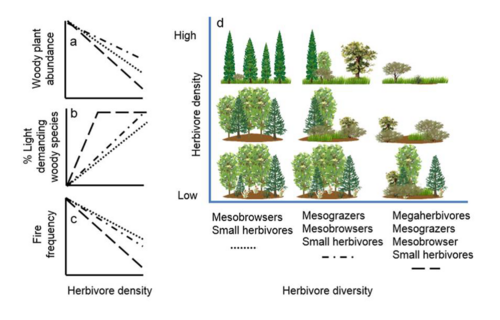

WORK PACKAGE 3: Field-based testing.
Aim: To provide field-based testing of key hypotheses on megafauna functional community assembly and ecosystem effects. Notably, we want to
Background: Given the pervasive human impacts on megafauna, we currently have little knowledge on natural population levels, the role of trophic complexity (e.g. types of carnivores), and interactions with spatial habitat distribution for the functioning of megafauna. This is a key shortcoming, as these aspects are crucial for designing megafauna conservation and restoration.
Methodology: The methods to achieve this understanding include meta-analyses of existing field and experimental studies as well as new studies in some of the most complete remaining megafauna (Maasai Mara, Kenya; Pantanal, Brazil) and in Denmark, e.g., in relation to reintroduction projects. The meta-analyses will include testing effects of herbivore densities and functional diversity on woody plant abundance, species composition and fire frequency (Fig. 2: predictions from one of our forthcoming PNAS papers) and be used to assess carrying capacity as a function of environment and megafauna functional diversity. Fieldwork in Pantanal and Maasai Mara will also be used to test Fig. 2, e.g., woody plant demographic structure, level of associational resistance (unpalatable species), and plant forage quality (C:N:P) under different grazing regimes (natural variation and with/without livestock) and across landscape gradients. Experimental studies will focus on megafauna herbivory effects, e.g., mimicking elephant destruction of trees and assessing herbaceous and small-animal diversity responses.